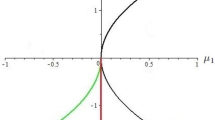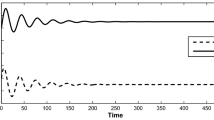Abstract
In this paper, we revisit a Leslie type predator–prey system with strong Allee effect on prey and simplified Holling type IV functional response proposed. Some more complex dynamical properties have been discovered. First, it is proved that the system exhibits a degenerate cusp of codimension 4 and a degenerate focus, saddle or elliptic of codimension 3 for different parameter values analytically. Further, various possible high codimensional bifurcation analyses are performed. It is shown that the system undergoes degenerate focus, saddle or elliptic type Bogdanov–Takens bifurcation of codimension 3 and degenerate cusp type Bogdanov–Takens bifurcation of codimension 4 as the parameters vary. Moreover, the existence and spatial location of the limit cycles are explored by calculating Hopf bifurcation and homoclinic bifurcation surfaces. Numerical simulations are carried out, and it is observed that three limit cycles coexist.











Similar content being viewed by others
Data Availibility
All data generated or analysed during this study are included in this published article.
References
Lotka, A.J.: Elements of Physical Biology. Williams & Wilkins, Baltimore (1925)
Volterra, V.: Fluctuations in the abundance of a species considered mathematically. Nature 118, 558–560 (1926)
Naik, P.A., Eskandari, Z., Jian, Z., et al.: Multiple bifurcations of a discrete-time prey-predator model with mixed functional response. Int. J. Bifurc. Chaos 32(3), 1–15 (2022)
Naik, P.A., Eskandari, Z., Yavuz, M., et al.: Complex dynamics of a discrete-time Bazykin–Berezovskaya prey–predator model with a strong Allee effect. J. Comput. Appl. Math. 413, 114401 (2022)
Naik, P.A., Eskandari, Z., Shahraki, H.E.: Flip and generalized flip bifurcations of a two-dimensional discrete-time chemical model. Math. Model. Numer. Simul. Appl. 1(2), 95–101 (2021)
Dawes, J.H.P., Souza, M.O.: A derivation of Holling’s type I, II and III functional responses in predator-prey systems. J. Theor. Biol. 327(1), 11–22 (2013)
Huang, J., Ruan, S., Song, J.: Bifurcations in a predator-prey system of Leslie type with generalized Holling type III functional response. J. Differ. Equ. 257(6), 1721–1752 (2014)
Shang, Z., Qiao, Y., Duan, L., et al.: Stability and bifurcation analysis in a nonlinear harvested predator-prey model with simplified Holling type IV functional response. Int. J. Bifurc. Chaos 30(14), 2050205 (2020)
Lajmiri, Z., Khoshsiar Ghaziani, R., Orak, I.: Bifurcation and stability analysis of a ratio-dependent predator–prey model with predator harvesting rate. Chaos Solitons Fract. 106, 193–200 (2018)
Bai, D., Li, J., Zeng, W.: Global stability of the boundary solution of a nonautonomous predator-prey system with beddington-deangelis functional response. J. Biol. Dynam. 14(1), 421–437 (2020)
Chen, X., Du, Z.: Existence of positive periodic solutions for a neutral delay predator-prey model with Hassell-Varley type functional response and impulse. Qual. Theory Dyn. Syst. 17, 67–80 (2018)
Cosner, C., Deangelis, D.L., Ault, J.S., Olson, D.B.: Effects of spatial grouping on the functional response of predators. Theor. Popul. Biol. 56(1), 65–75 (1999)
Li, Y., Xiao, D.: Bifurcations of a predator-prey system of Holling and Leslie types. Chaos Solitons Fract. 34, 606–620 (2007)
Huang, J., Xia, X., Zhang, X., et al.: Bifurcation of codimension 3 in a predator-prey system of Leslie type with simplified Holling type IV functional response. Int. J. Bifurc. Chaos 26(2), 1650034 (2016)
Dai, Y., Zhao, Y.: Hopf cyclicity and global dynamics for a predator-prey system of Leslie type with simplified Holling type IV functional response. Int. J. Bifurc. Chaos 28(13), 1850166 (2018)
Allee, W.C.: Animal Aggregation: A Study in General Sociology. University of Chicago Press, Chicago (1931)
Courchamp, F., Clutton-Brock, T., Grenfell, B.: Inverse density dependence and the Allee effect. Trends Ecol. Evol. 14(10), 405–410 (1999)
Kramer, A., Berec, L., Drake, J.: Allee effects in ecology and evolution. J. Anim. Ecol. 87(1), 7–10 (2018)
Liermann, M., Hilborn, R.: Depensation: evidence, models and implications. Fish Fish. 2(1), 33–58 (2001)
González-Olivares, E., Cabrera-Villegas, J., Córdova-Lepe, F., et al.: Competition among predators and Allee effect on prey, their influence on a Gause-type predation model. Math. Probl. Eng. 2019, 1–19 (2019)
Stephens, P.A., Freckleton, W.: What is the Allee effect? Oikos 87(1), 185–190 (1999)
Courchamp, F., Berec, L., Gascoigne, J.: Allee effects in ecology and conservation. Environ. Conserv. 36 (2008)
Boukal, D.S., Sabelis, M.W., Berec, L.: How predator functional responses and Allee effects in prey affect the paradox of enrichment and population collapses. Theor. Popul. Biol. 72(1), 136–147 (2007)
Berec, L., Angulo, E., Courchamp, F.: Multiple Allee effects and population management. Trends Ecol. Evol. 22(4), 185–191 (2007)
Singh, M.K., Bhadauria, B.S., Singh, B.K.: Bifurcation analysis of modified Leslie-Gower predator-prey model with double Allee effect. Ain Shams Eng. J. 94, 1263 (2016)
Arancibia-Ibarra, C., Flores, J.D., Pettet, G., et al.: A Holling-Tanner predator-prey model with strong Allee effect. Int. J. Bifurc. Chaos 29(11), 1930032 (2019)
Pal, P.J., Saha, T.: Dynamical Complexity of a Ratio-Dependent Predator-Prey Model with Strong Additive Allee Effect. Springer, India (2015)
Wang, W., Zhang, Y., Liu, C.: Analysis of a discrete-time predator–prey system with Allee effect. Ecol. Complex. 8(1), 81–85 (2011)
Shang, Z., Qiao, Y.: Bifurcation analysis of a Leslie-type predator-prey system with simplified Holling type IV functional response and strong Allee effect on prey. Nonlinear Anal. Real. 64, 103453 (2022)
Perko, L., Differential Equations and Dynamical Systems, third ed., in: Texts in Applied Mathematics, Vol. 7, Springer, New York (2001)
Lamontagne, Y., Coutu, C., Rousseau, C.: Bifurcation analysis of a predator-prey system with generalised Holling type III functional response. J. Dyn. Differ. Equ. 20(3), 535–571 (2008)
Cai, L., Chen, G., Xiao, D.: Multiparametric bifurcations of an epidemiological model with strong Allee effect. J. Math. Biol. 67(2), 185–215 (2013)
Dumortier, F., Roussarie, R., Sotomayor, J.: Generic 3-parameter families of vector fields on the plane, unfolding a singularity with nilpotent linear part: the cusp case of codimension. Erg. Theor. Dyn. Syst. 7(3), 375–413 (1987)
Dumortier, F., Roussarie, R., Sotomayor, J., et al.: Bifurcation of planar vector fields, nilpotent singularities and abelian integrals. Lecture Notes in Mathematics, vol. 1480. Springer-Verlag, Berlin (1991)
Chow, S.N., Li, C., Wang, D.: Normal Forms and Bifurcation of Planar Vector Fields. Cambridge University Press, New York (1994)
Li, C., Rousseau, C.: A system with three limit cycles appearing in a Hopf bifurcation and dying in a homoclinic bifurcation: the cusp of order 4. J. Differ. Equ. 79(1), 132–167 (1989)
Joyal, P.: The cusp of order n. J. Differ. Equ. 88(1), 1–14 (1990)
Shi, S.: A method of constructing cycles without contact around a weak focus. J. Differ. Equ. 41(3), 301–312 (1981)
Joyal, P., Rousseau, C.: Saddle quantities and applications. J. Differ. Equ. 78(2), 374–399 (1989)
Joyal, P.: La bifurcation de Hopf généralisée et son dual: la bifurcation homoclinique généralisée. Université de Montréal, Thesis (1986)
Acknowledgements
We thank to the editors and the anonymous reviewers for their valuable comments, which improved the presentation of this paper. This work is supported by Beijing Municipal Natural Science Foundation (No.4202025).
Author information
Authors and Affiliations
Contributions
ZS: Conceptualization, methodology, data curation, writing-original draft preparation, software. YQ: Writing-reviewing and editing, validation, investigation, supervision.
Corresponding author
Ethics declarations
Conflict of interest
The authors declare that there are no conflicts of interest in publishing this paper.
Additional information
Publisher's Note
Springer Nature remains neutral with regard to jurisdictional claims in published maps and institutional affiliations.
Appendices
Appendix A
The coefficient expressions of system (6) are listed as follows.
\(p_{1}=\dfrac{1}{2c(-m-1+\sqrt{(m-1)^{2}-4c})}((-2\,m^{3}+3mc+2\,m^{2}+3c+2\,m-2)\sqrt{(m-1)^{2}-4c} +2\,m^{4}-7\,m^{2}c-4\,m^{3}-2c^{2}+2mc+4\,m^{2}-7c-4\,m+2)\),
\(p_{2}=-\sqrt{(m-1)^{2}-4c}\),
\(p_{3}=-\dfrac{1}{c^{2}(-m-1+\sqrt{(m-1)^{2}-4c})^{2}}((2\,m^{5}-4\,m^{4}+13c^{2}-12\,m^{3}c+13mc^{2}+4\,m^{2}c+2\,m^{3} -12c+2\,m^{2}+4mc-4\,m+2)\sqrt{(m-1)^{2}-4c}-2\,m^{6}+6\,m^{5}-6\,m^{4}-2+8\,m^{2}c+4\,m^{3}-20mc+16\,m^{4}c-33\,m^{2}c^{2} -20\,m^{3}c-10mc^{2}-33c^{2}+10c^{3}-6\,m^{2}+16c+6\,m)\),
\(p_{4}=\dfrac{-1}{c(-m-1+\sqrt{(m-1)^{2}-4c})^{2}}((m+1)\sqrt{(m-1)^{2}-4c}-(m-1)^{2} +5c)((m+1)\sqrt{(m-1)^{2}-4c}-(m-1)^{2}+2c)\),
\(p_{5}=\dfrac{1}{2c^{3}(-m-1+\sqrt{(m-1)^{2}-4c})^{3}}(((-26\,m^{3}c+37mc^{2}+10\,m^{2}c+4\,m^{5}-8\,m^{4}+37c^{3}+10mc+4+4\,m^{3}+4\,m^{2} -26c-8\,m)\sqrt{(m-1)^{2}-4c}-4-4\,m^{6}+12\,m^{5}+34\,m^{4}c-81\,m^{2}c^{2}-44\,m^{3}c-14mc^{2}+38c^{3}+20\,m^{2}c-44mc-81c^{2} +8\,m^{3}-12\,m^{4}-12\,m^{2}+34c+12\,m)((m+1)\sqrt{(m-1)^{2}-4c}-(m-1)^{2}+2c))\),
\(p_{6}=\dfrac{2}{c^{2}(-m-1+\sqrt{(m-1)^{2}-4c})^{3}}((-m^{3}+4mc+m^{2}+4c+m-1)\sqrt{(m-1)^{2}-4c}+m^{4}-6\,m^{2}c-2\,m^{3}+7c^{2} +4mc+2\,m^{2}-6c-2\,m+1)((m+1)\sqrt{(m-1)^{2}-4c}-(m-1)^{2}+2c)\),
\(p_{7}=\dfrac{-1}{2c^{4}(-m-1+\sqrt{(m-1)^{2}-4c})^{4}}((4+4\,m^{3}-28c+4\,m^{2}-8\,m+4\,m^{5}-8\,m^{4}+45c^{2}+45c^{2}m +12c m^{2}-28c m^{3}+12mc+4c+m-1)\sqrt{(m-1)^{2}-4c}-4+36c m^{4}-93c^{2}m^{2}-48c m^{3}-6c^{2}m+52c^{3}-4\,m^{6}+12\,m^{5}-12\,m^{4}-93c^{2}+8\,m^{3}-12\,m^{2}+24c m^{2}-48mc+36c+12\,m)((m+1)\sqrt{(m-1)^{2}-4c}-(m-1)^{2}+2c)\),
\(p_{8}=-\dfrac{((m+1)\sqrt{(m-1)^{2}-4c}-(m-1)^{2}+2c)^{2}}{c^{3}(-m-1+\sqrt{(m-1)^{2}-4c})^{4}}((-2\,m^{3}+9mc+2\,m^{2}+9c+2\,m-2)\sqrt{(m-1)^{2}-4c}+2\,m^{4} -13\,m^{2}c-4\,m^{3}+19c^{2}+10mc+4\,m^{2}-13c-4\,m+2)\),
\(q_{1}=q_{3}=\dfrac{-q_{2}}{2}=\dfrac{-2c}{(m+1-\sqrt{(m-1)^{2}-4c})}\),
\(q_{4}=q_{6}=\dfrac{-q_{5}}{2}=\dfrac{4c}{(m+1-\sqrt{(m-1)^{2}-4c})^{2}}\),
\(q_{7}=q_{9}=\dfrac{-q_{8}}{2}=\dfrac{-8c}{(m+1-\sqrt{(m-1)^{2}-4c})^{3}}\),
\(q_{10}=q_{12}=\dfrac{-q_{11}}{2}=\dfrac{16c}{(m+1-\sqrt{(m-1)^{2}-4c})^{4}}\).
Appendix B
The coefficient expressions of system (9) are listed as follows.
\(\phi _{1}=c(p_{1}+p_{2})\), \(\phi _{2}=-\dfrac{p_{2}+q_{3}}{c}\), \(\phi _{3}=c(p_{3}+p_{4})\), \(\phi _{4}=3p_{3}+2p_{4}+\dfrac{(p_{2}+2q_{3})(p_{1}+p_{2})}{c}\),
\(\phi _{5}=-\dfrac{2cp_{4}+cq_{6}+p_{2}^{2}+p_{2}q_{3}}{c^{2}}\), \(\phi _{6}=cp_{5}+cp_{6}-\dfrac{(p_{1}+p_{2})^{2}q_{3}}{c}\),
\(\phi _{7}=4p_{5}+3p_{6}+\dfrac{(p_{2}^{2}+2p_{2}q_{3}+2cq_{6})(p_{1}+p_{2})}{c^{2}}+\dfrac{(p_{2}+2p_{3}+2p_{4})q_{3} +(2p_{1}+3p_{2})p_{4}}{c}\),
\(\phi _{8}=-\dfrac{3p_{6}+q_{9}}{c}-\dfrac{3p_{2}p_{4}+p_{2}q_{6}+p_{4}q_{3}}{c^{2}}-\dfrac{p_{2}^{2}(p_{2}+q_{3})}{c^{3}}\).
Appendix C
The coefficient expressions of system (16) are listed as follows.
\(g_{30}=p_{3}+p_{4}\), \(g_{21}=-\dfrac{1}{c^{2}}(cp_{4}+p_{2}^{2}+p_{2}q_{3})\), \(g_{40}=-\dfrac{1}{2c}(p_{3}+p_{4})(p_{2}+q_{3})+p_{5}+p_{6}\), \(g_{31}=-\dfrac{1}{c^{3}}(c^{2}p_{6}-cp_{4}q_{3}-p_{2}^{3}-3p_{2}^{2}q_{3}-2p_{2}q_{3}^{2})\), \(h_{11}=-p_{2}\), \(h_{30}=c(p_{3}+p_{4})\), \(h_{21}=\dfrac{p_{2}(p_{2}+q_{3})}{2c}-p_{4}\), \(h_{12}=-\dfrac{1}{c^{2}}(cq_{6}+p_{2}q_{3}+q_{3}^{2})\), \(h_{40}=-\dfrac{3}{2}p_{2}p_{3}-\dfrac{3}{2}p_{2}p_{4}-\dfrac{1}{2}p_{3}q_{3}-\dfrac{1}{2}p_{4}q_{3}+cp_{5}+cp_{6}\), \(h_{31}=-\dfrac{1}{2c^{2}}(2c^{2}p_{6}-2cp_{2}p_{4}-2cp_{3}q_{3}-4cp_{4}q_{3}+p_{2}^{3}+2p_{2}^{2}q_{3}+p_{2}q_{3}^{2})\), \(h_{22}=-\dfrac{1}{2c^{3}}(2c^{2}q_{9}-cp_{2}q_{6}+2cp_{4}q_{3}-3cq_{3}q_{6}-p_{2}^{2}q_{3}-6p_{2}q_{3}^{2}-5q_{3}^{3})\).
Appendix D
The coefficient expressions of system (19) are listed as follows.
\(k_{00}=x_{{2}} ( -x_{{2}}+1 ) ( -m+x_{{2}} ) -\dfrac{ x_{{2}}^{2}}{a_{{0}}+\lambda _{{1}}+ ( b_{{0}}+\lambda _{{2}} ) x_{{2}}^{2}}\),
\(k_{10}=x_{{2}} ( -x_{{2}}+1 ) + ( -2\,x_{{2}}+1 ) ( -m+x_{{2}} ) -\dfrac{x_{{2}} ( -x_{{2}}^{2}b_{{0 }}-x_{{2}}^{2}\lambda _{{2}}+a_{{0}}+\lambda _{{1}} ) }{ ( x_{{2}}^{2}b_{{0}}+x_{{2}}^{2}\lambda _{{2}}+a_{{0}}+\lambda _{{1}} ) ^{2}}\),
\(k_{01}=-\dfrac{x_{{2}}}{a_{{0}}+\lambda _{{1}}+ ( b_{{0}}+\lambda _{{2}} ) x_{{2}}^{2}}\), \(k_{11}=-\dfrac{-x_{{2}}^{2}b_{{0}}-x_{{2}}^{2}\lambda _{{2}}+a_{{0}}+ \lambda _{{1}}}{(x_{{2}}^{2}b_{{0}}+x_{{2}}^{2}\lambda _{{2}}+a_{{0}}+ \lambda _{{1}})^{2}}\),
\(k_{20}=-3\,x_{{2}}+1+m+\dfrac{ ( b_{{0}}+\lambda _{{2}} ) x_{{2}} ^{2} ( -x_{2}^{2}b_{{0}}-x_{{2}}^{2}\lambda _{{2}}+3\,a_{{0 }}+3\,\lambda _{{1}} ) }{ ( x_{{2}}^{2}b_{{0}}+x_{{2}}^{ 2}\lambda _{{2}}+a_{{0}}+\lambda _{{1}} ) ^{3}}\),
\(k_{30}=-1+\dfrac{x_{{2}} ( b_{{0}}+\lambda _{{2}} )}{ ( x_{{2}}^{2}b_{{0}}+x_{{2}}^{2 }\lambda _{{2}}+a_{{0}}+\lambda _{{1}} ) ^{4}} ( b_{{0 }}^{2}x_{{2}}^{4}+2\,b_{{0}}\lambda _{{2}}x_{{2}}^{4}+\lambda _{{2 }}^{2}x_{{2}}^{4}-6\,a_{{0}}b_{{0}}x_{{2}}^{2}-6\,a_{{0}}\lambda _ {{2}}x_{{2}}^{2}-6\,b_{{0}}\lambda _{{1}}x_{{2}}^{2}-6\,\lambda _{{1 }}\lambda _{{2}}x_{{2}}^{2}+{a_{{0}}}^{2}+2\,a_{{0}}\lambda _{{1}}+ \lambda _{{1}}^{2} )\),
\(k_{21}={\dfrac{x_{{2}} ( b_{{0}}+\lambda _{{2}} ) ( -x_{{2} }^{2}b_{{0}}-x_{{2}}^{2}\lambda _{{2}}+3\,a_{{0}}+3\,\lambda _{{1}} ) }{ ( x_{{2}}^{2}b_{{0}}+x_{{2}}^{2}\lambda _{{2}}+a_{ {0}}+\lambda _{{1}} ) ^{3}}}\), \(l_{10}=c_{0}+\lambda _{3}\), \(l_{01}=-c_{0}-\lambda _{3}\), \(l_{20}=-\dfrac{c_{0}+\lambda _{3}}{x_{2}}\), \(l_{11}=\dfrac{2(c_{0}+\lambda _{3})}{x_{2}}\), \(l_{02}=-\dfrac{c_{0}+\lambda _{3}}{x_{2}}\), \(l_{30}=\dfrac{c_{0}+\lambda _{3}}{x_{2}^{2}}\), \(l_{21}=-\dfrac{2(c_{0}+\lambda _{3})}{x_{2}^{2}}\), \(l_{12}=\dfrac{c_{0}+\lambda _{3}}{x_{2}^{2}}\).
Appendix E
The coefficient expressions of system (20) are listed as follows.
\(m_{00}=\dfrac{k_{{00}} ( k_{{00}}l_{{02}}-k_{{01}}l_{{01}} ) }{k_{{01}}}\),
\(m_{10}=\dfrac{l_{{12}}k_{{00}}^{2}k_{{01}}-k_{{00}}^{2}k_{{11}}l_{{02}}-l_{{ 11}}k_{{00}}k_{{01}}^{2}+2\,k_{{00}}k_{{01}}k_{{10}}l_{{02}}+l_{{10}}k_{ {01}}^{3}-k_{{01}}^{2}k_{{10}}l_{{01}}}{k_{{01}}^{2}}\),
\(m_{01}=-\dfrac{k_{{00}}k_{{11}}+2\,k_{{00}}l_{{02}}-k_{{01}}k_{{10}}-k_{{01}}l_{{ 01}}}{k_{{01}}}\),
\(m_{20}=-\dfrac{1}{k_{01}^{3}}(k_{{00}}^{2}k_{{01}}k_{{11}}l_{{12}}+k_{{00}}^{2}k_{{01}}k_{{ 21}}l_{{02}}-k_{{00}}^{2}k_{{11}}^{2}l_{{02}}+l_{{21}}k_{{00}}k_{{01}} ^{3}-2\,k_{{00}}k_{{01}}^{2}k_{{10}}l_{{12}}-2\,k_{{00}}k_{{01}}^{2}k _{{20}}l_{{02}}+2\,k_{{00}}k_{{01}}k_{{10}}k_{{11}}l_{{02}}-l_{{20}}k_{{01 }}^{4}+k_{{01}}^{3}k_{{10}}l_{{11}}-k_{{01}}^{3}k_{{11}}l_{{10}}+k _{{01}}^{3}k_{{20}}l_{{01}}-k_{{01}}^{2}k_{{10}}^{2}l_{{02}})\),
\(m_{11}=-\dfrac{1}{k_{{01}}^{2}}(2\,k_{{00}}k_{{21}}k_{{01}}+2\,l_{{12}}k_{{00}}k_{{01}}-k_{{00}}k_{{11}}^{2}-2\,k_{{00}} k_{{11}}l_{{02}}-2\,k_{{20}}k_{{01}}^{2}-l_{{11 }}k_{{01}}^{2}+k_{{01}}k_{{10}}k_{{11}}+2\,k_{{01}}k_{{10}}l_{{02}})\), \(m_{02}=\dfrac{l_{{02}}+k_{{11}}}{k_{{01}}}\),
\(m_{30}=-\dfrac{1}{k_{{01}}^{4}}(k_{{00}}^{2}k_{{01}}^{2}k_{{21}}l_{{12}}-k_{{00}}^{2}k_{{01 }}k_{{11}}^{2}l_{{12}}-2\,k_{{00}}^{2}k_{{01}}k_{{11}}k_{{21}}l_{{02} }+k_{{00}}^{2}k_{{11}}^{3}l_{{02}}-2\,k_{00}k_{{01}}^{3}k_{{20}}l_ {{12}}-2\,k_{{00}}k_{{01}}^{3}k_{{30}}l_{{02}}+2\,k_{{00}}k_{{01}}^{2}k _{{10}}k_{{11}}l_{{12}}+2\,k_{{00}}k_{{01}}^{2}k_{{10}}k_{{21}}l_{{02}} +2\,k_{{00}}k_{{01}}^{2}k_{{11}}k_{{20}}l_{{02}}-2\,k_{{00}}k_{{01}}k_{{ 10}}k_{{11}}^{2}l_{{02}}-l_{{30}}k_{{01}}^{5}+k_{{01}}^{4}k_{{10}}l _{{21}}-k_{{01}}^{4}k_{{11}}l_{{20}}+k_{{01}}^{4}k_{{20}}l_{{11}}-k _{{01}}^{4}k_{{21}}l_{{10}}+k_{{01}}^{4}k_{{30}}l_{{01}}-k_{{01}}^{3} k_{{10}}^{2}l_{{12}}-2\,k_{{01}}^{3}k_{{10}}k_{{20}}l_{{02}}+k_{{01} }^{2}k_{{10}}^{2}k_{{11}}l_{{02}})\),
\(m_{21}=\dfrac{1}{k_{{01}}^{3}}(3\,k_{{00}}k_{{01}}k_{{11}}k_{{21}}+2\,k_{{00}}k_{{01}}k_{{11}}l_{ {12}}+2\,k_{{00}}k_{{01}}k_{{21}}l_{{02}}-k_{{00}}k_{{11}}^{3}-2\,k_{{00} }k_{{11}}^{2}l_{{02}}+3\,k_{{01}}^{3}k_{{30}}+l_{{21}}k_{{01}}^{3}- 2\,k_{{01}}^{2}k_{{10}}k_{{21}}-2\,k_{{01}}^{2}k_{{10}}l_{{12}}-k_{ {01}}^{2}k_{{11}}k_{{20}}-2\,k_{{01}}^{2}k_{{20}}l_{{02}}+k_{{01}}k_{{ 10}}k_{{11}}^{2}+2\,k_{{01}}k_{{10}}k_{{11}}l_{{02}})\),
\(m_{12}=\dfrac{2\,k_{{21}}k_{{01}}+l_{{12}}k_{{01}}-k_{{11}}^{2}-l_{{02}}k_{{ 11}}}{k_{{01}}^{2}}\).
Rights and permissions
Springer Nature or its licensor (e.g. a society or other partner) holds exclusive rights to this article under a publishing agreement with the author(s) or other rightsholder(s); author self-archiving of the accepted manuscript version of this article is solely governed by the terms of such publishing agreement and applicable law.
About this article
Cite this article
Shang, Z., Qiao, Y. Bogdanov–Takens Bifurcation of Codimensions 3 and 4 in a Holling and Leslie type Predator–Prey System with Strong Allee Effect. Qual. Theory Dyn. Syst. 23, 23 (2024). https://doi.org/10.1007/s12346-023-00880-2
Received:
Accepted:
Published:
DOI: https://doi.org/10.1007/s12346-023-00880-2




